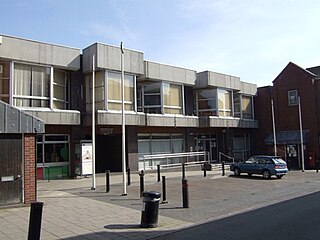
Dronfield is a town in North East Derbyshire, England, which includes Dronfield Woodhouse and Coal Aston. It lies in the valley of the River Drone between Chesterfield and Sheffield. The Peak District National Park is three miles (4.8 km) to the west. The name comes from the Old English Dranfleld, probably meaning an open land infested with drone bees.

Camden Town Hall, known as St Pancras Town Hall until 1965, is the meeting place of Camden London Borough Council. The main entrance is in Judd Street with its northern elevation extending along Euston Road, opposite the main front of St Pancras railway station. It was completed in 1937 and has been Grade II listed since 1996.

Bolton Town Hall in Victoria Square, Bolton, Greater Manchester, England, was built between 1866 and 1873 for the County Borough of Bolton to designs by William Hill of Leeds and George Woodhouse of Bolton. The town hall was extended in the 1930s to the designs of Bradshaw, Gass and Hope and has been designated a Grade II* listed building by English Heritage.

Corn exchanges are distinct buildings which were originally created as a venue for corn merchants to meet and arrange pricing with farmers for the sale of wheat, barley, and other corn crops. The word "corn" in British English denotes all cereal grains, such as wheat and barley. With the repeal of the Corn Laws in 1846, a large number of corn exchanges were built in England, particularly in the corn-growing areas of Eastern England.

Nuneaton Town Hall is a municipal building on Coton Road in the town of Nuneaton, Warwickshire, England. The building is the headquarters of Nuneaton and Bedworth Borough Council.

Hyde Town Hall is a municipal building in the Market Street, Hyde, Greater Manchester, England. The town hall, which was the headquarters of Hyde Borough Council, is a grade II listed building.

Chadderton Town Hall is a municipal building on Middleton Road, Chadderton, Greater Manchester, England. The town hall, which was the headquarters of Chadderton Urban District Council, is a grade II listed building.

The Old Town Hall is a municipal building in Queen Charlotte Street, Leith, Scotland. The old town hall, which was the meeting place of Leith Burgh Council, is now used as a police station. It is a Category A listed building.

Worthing Town Hall, or New Town Hall, is a municipal building in Chapel Road, Worthing, West Sussex, England. The town hall, which is a meeting place of Worthing Borough Council, is a Grade II listed building. Located at Chapel Road in the centre of Worthing, it was opened in 1933 and built in a neo-Georgian style to designs by Charles Cowles-Voysey. Containing offices and a Council chamber it replaced Worthing's Old Town Hall as the administrative centre, a building that had been the home of Worthing's local authority from 1835 and was demolished in 1966. To the rear and west lies the Assembly Hall, built in 1935, also to designs by Cowles-Voysey. To the south lies the Worthing Museum and Art Gallery, originally built as a Carnegie Library.

Neath Town Hall is a municipal building in Church Place, Neath, South Wales. The town hall, which was the headquarters of Neath Borough Council, is a Grade II listed building.

Newport Guildhall is a municipal structure in the High Street in Newport, Isle of Wight, England. The guildhall, which was the headquarters of Newport Borough Council, is a Grade II* listed building.

The Moot Hall is a municipal building in Chapel Lane in Daventry, Northamptonshire, England. The building, which was the headquarters of Daventry Borough Council, is a Grade II* listed building.

Tewkesbury Town Hall is a municipal building in the High Street in Tewkesbury, Gloucestershire, England. The building, which is the meeting place of Tewkesbury Town Council, is a Grade II* listed building.

The Roe Valley Arts & Cultural Centre, formerly the Alexander Memorial Hall and originally Limavady Town Hall, is a civic venue in Main Street in Limavady, County Londonderry, Northern Ireland. The structure, which incorporates the façade of the old town hall, was previously a Grade B1 listed building but was delisted in July 1998 to facilitate the demolition of the structure behind the façade and the subsequent erection of a new cultural centre.

The Buttercross, also known as Brigg Town Hall, is a municipal building in the Market Place in Brigg, Lincolnshire, England. The structure, which is used as a tourist information centre and as an events venue, is a Grade II listed building.

Carrick-on-Suir Town Hall is a municipal building in New Street, Carrick-on-Suir, County Tipperary, Ireland. The building accommodated the offices of Carrick-on-Suir Town Council until 2014 but is now used by Tipperary County Council for the provision of services to local residents.

Bakewell Town Hall is a municipal building in Anchor Street in Bakewell, a town in Derbyshire in England. The building, which serves a community events venue, is also the home of Bakewell Town Council.

Stubbylee Hall, formerly known as Bacup Town Hall, is a former municipal building in Stubbylee Lane in Bacup, a town in Lancashire in England. The building, which served as the offices and meeting place of Bacup Borough Council, is a Grade II listed building.

Whitchurch Civic Centre is a municipal building in Whitchurch, a town in Shropshire, in England. It accommodated the offices of Whitchurch Town Council until September 2023, when the building was closed, following the discovery of potentially dangerous reinforced autoclaved aerated concrete.

The Shanklin Theatre is an entertainment venue in Prospect Road in Shanklin, a town on the Isle of Wight in England. The building, which incorporates the former Shanklin Town Hall, is a Grade II listed building.






















